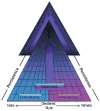The p Factor: One General Psychopathology Factor in the Structure of Psychiatric Disorders?
- PMID: 25360393
- PMCID: PMC4209412
- DOI: 10.1177/2167702613497473
The p Factor: One General Psychopathology Factor in the Structure of Psychiatric Disorders?
Abstract
Mental disorders traditionally have been viewed as distinct, episodic, and categorical conditions. This view has been challenged by evidence that many disorders are sequentially comorbid, recurrent/chronic, and exist on a continuum. Using the Dunedin Multidisciplinary Health and Development Study, we examined the structure of psychopathology, taking into account dimensionality, persistence, co-occurrence, and sequential comorbidity of mental disorders across 20 years, from adolescence to midlife. Psychiatric disorders were initially explained by three higher-order factors (Internalizing, Externalizing, and Thought Disorder) but explained even better with one General Psychopathology dimension. We have called this dimension the p factor because it conceptually parallels a familiar dimension in psychological science: the g factor of general intelligence. Higher p scores are associated with more life impairment, greater familiality, worse developmental histories, and more compromised early-life brain function. The p factor explains why it is challenging to find causes, consequences, biomarkers, and treatments with specificity to individual mental disorders. Transdiagnostic approaches may improve research.
Keywords: DSM; developmental psychopathology; psychiatric epidemiology.
Conflict of interest statement
The authors declared that they had no conflicts of interest with respect to their authorship or the publication of this article.
Figures



References
-
- Achenbach TM, Edelbrock C. Behavioral problems and competencies reported by parents of normal and disturbed children aged 4 through 16. Monographs of the Society for Research in Child Development. 1981;46(188) - PubMed
-
- American Psychiatric Association. Diagnostic and statistical manual of mental disorders. 4. Washington, DC: Author; 1994.
-
- American Psychiatric Association. Diagnostic and statistical manual of mental disorders. 5. Arlington, VA: American Psychiatric Publishing; 2013.
-
- Asparouhov T, Muthen B. Weighted least squares estimation with missing data. 2010 Retrieved from http://www.statmodel.com/download/GstrucMissingRevision.pdf.
-
- Barlow DH, Farchione TJ, Fairholme CP, Ellard KK, Boisseau CL, Allen LB, Ehrenreich-May J. The unified protocol for transdiagnostic treatment of emotional disorders: Therapist guide. New York, NY: Oxford University Press; 2011.
Grants and funding
LinkOut - more resources
Full Text Sources
Other Literature Sources
